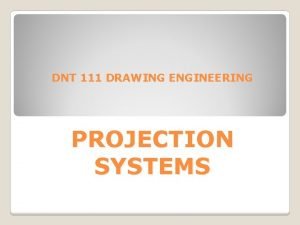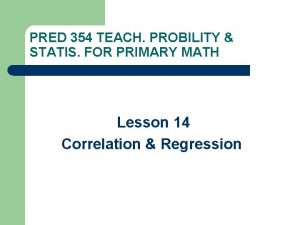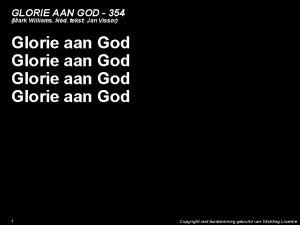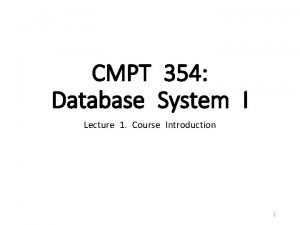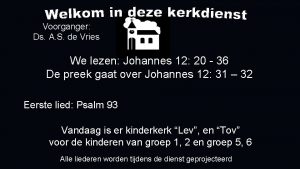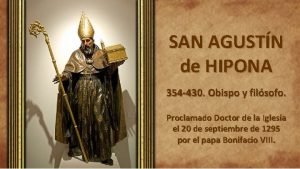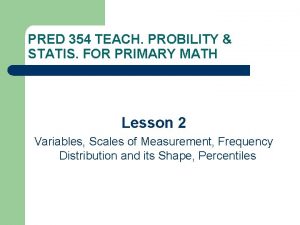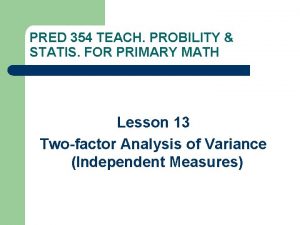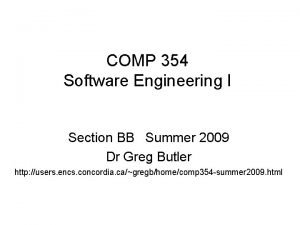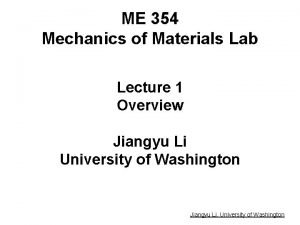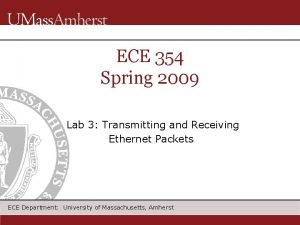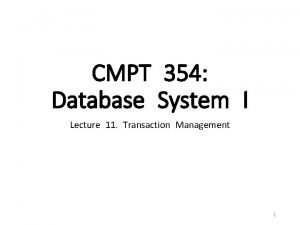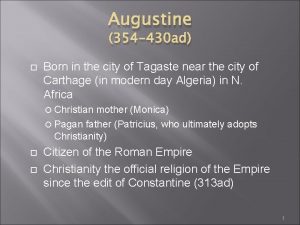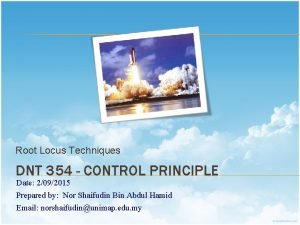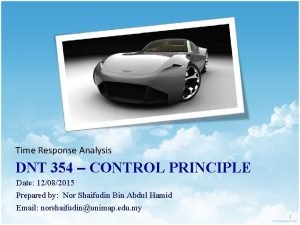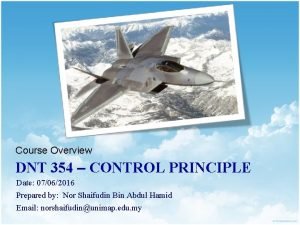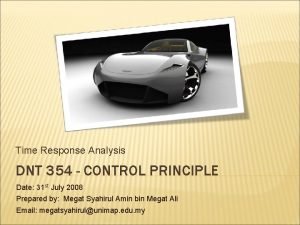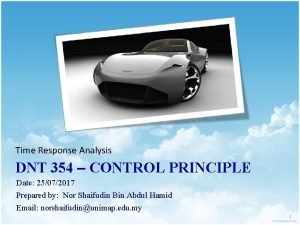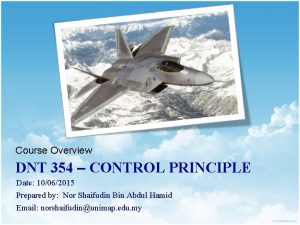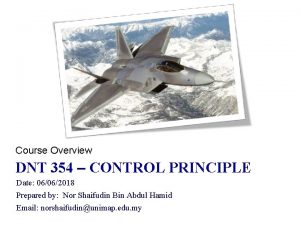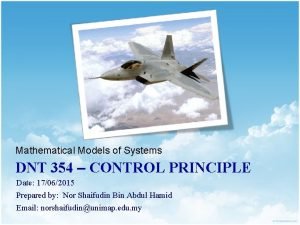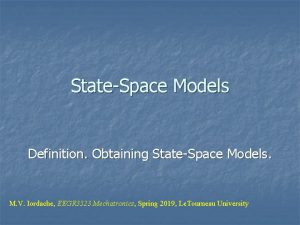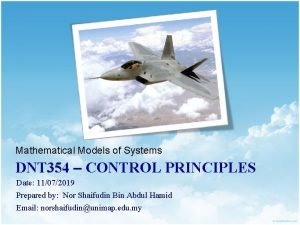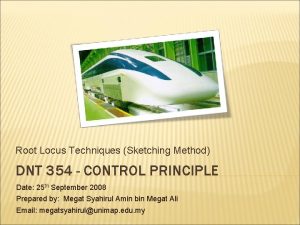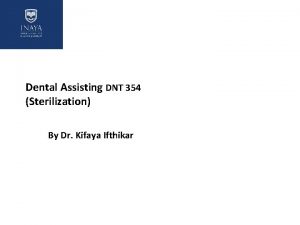StateSpace Models DNT 354 CONTROL PRINCIPLE Date 29072015
























- Slides: 24

State-Space Models DNT 354 – CONTROL PRINCIPLE Date: 29/07/2015 Prepared by: Nor Shaifudin Bin Abdul Hamid Email: norshaifudin@unimap. edu. my

CONTENTS • Introduction • State-Space Model • Signal Flow Graph

INTRODUCTION • The basic questions that will be addressed in state-space approach include: i. What are state-space models? ii. Why should we use them? iii. How are they related to the transfer function used in classical control system? iv. How do we develop a space-state model?

STATE-SPACE MODEL A representation of the dynamics of Nth-order system as a first-order equation in an Nvector, which is called the state. Convert the Nth-order differential equation that governs the dynamics of the system into N first-order differential equation.

STATE-SPACE MODEL • The state of a system is described by a set of first-order differential equations written in terms of the state variable.

STATE-SPACE MODEL • In a matrix form, we have: • State vector:

STATE SPACE MODEL Input equation Output equation

REPRESENTATION OF DYNAMIC SYSTEM • Example: Springer-mass-damper system Dynamic equation of the system: Therefore, we define variable x 1 and x 2. • The 2 first-order equations are:

REPRESENTATION OF DYNAMIC SYSTEM • Example: Springer-mass-damper system (cont. ) In matrix form: If the measured output of the system is position, then we have: General State-Space Model:

REPRESENTATION OF DYNAMIC SYSTEM • Example: Simple mechanical system Dynamic equation of the system: Let us define variable x 1 and x 2. The we will obtain:

REPRESENTATION OF DYNAMIC SYSTEM • Example: Simple mechanical system (cont. ) In vector form: The output equation:

REPRESENTATION OF DYNAMIC SYSTEM • Problem: Find the space-state for the following mechanical system.

REPRESENTATION OF DYNAMIC SYSTEM • Problem: Find the space-state for the following RLC circuit.

SIGNAL FLOW GRAPH • A signal flow graph is a graphical representation of the relationships between the variables of a set of linear algebraic equations. • The basic element of a signal flow graph is a unidirectional path segments called branch. • The input and output points or junctions are called nodes. • A path is a branch or continuous sequence or branches that can be traversed from one signal node to another signal node. • A loop is a closed path that originates and terminates on the same node, and along the path no node is met twice. • Two loops are said to be non-touching if they do not have a same common node.

SIGNAL FLOW GRAPH • Signal flow graph of control systems

SIGNAL FLOW GRAPH • Signal flow graph of control systems (cont. )

SIGNAL FLOW GRAPH • Mason’s Gain Formula for Signal Flow Graph Where, Pijk ∆ ∆ijk : kth path from variable xi to xj : Determinant of the graph : Cofactor of the path Pijk

SIGNAL FLOW GRAPH MODEL • Example: Transfer function of interacting system

SIGNAL FLOW GRAPH MODEL • Example: Transfer function of interacting system (cont. ) The paths connecting input R(s) to output Y(s) are: P 1 = G 1 G 2 G 3 G 4 P 2 = G 5 G 6 G 7 G 8 There are four individual loops: L 1 = G 1 H 1 L 2 = G 2 H 2 L 3 = G 3 H 3 L 4 = G 4 H 4

SIGNAL FLOW GRAPH MODEL • Example: Transfer function of interacting system (cont. ) Loops L 1 and L 2 does not touch loops L 3 and L 4. Therefore, the determinant is: The cofactor of the determinant along path 1 is evaluated by removing the loops that touch path 1 from ∆. Therefore have: and, Similarly, the cofactor for path 2 is:

SIGNAL FLOW GRAPH MODEL • Example: Transfer function of interacting system (cont. ) Therefore, the transfer function of the system is:

SIGNAL FLOW GRAPH MODEL • Problem: Obtain the closed-loop transfer function by use of Mason’s Gain Formula

FURTHER READING… • Chapter 3 i. ii. Dorf R. C. , Bishop R. H. (2001). Modern Control Systems (9 th Ed), Prentice Hall. Nise N. S. (2004). Control System Engineering (4 th Ed), John Wiley & Sons. • Chapter 5 i. Nise N. S. (2004). Control System Engineering (4 th Ed), John Wiley & Sons.

THE END…
 Dnt frivillig arbeid
Dnt frivillig arbeid Projection
Projection Dnt machine
Dnt machine Dnt travsport
Dnt travsport Dnt computer
Dnt computer Record date for dividend
Record date for dividend Dividend eligibility
Dividend eligibility Informe técnico 1466-2017-servir-gpgsc
Informe técnico 1466-2017-servir-gpgsc Informe técnico nº 1819-2018-servir-gpgsc
Informe técnico nº 1819-2018-servir-gpgsc Time bound promotion for doctors in tamilnadu
Time bound promotion for doctors in tamilnadu Pred-354
Pred-354 Glorie aan god tekst
Glorie aan god tekst Cmpt354
Cmpt354 Opwekking 354
Opwekking 354 354
354 Pred 354
Pred 354 Pred-354
Pred-354 Comp 354
Comp 354 Art 354 kc
Art 354 kc Me 354
Me 354 Cmpt 354
Cmpt 354 Ece 354
Ece 354 Cmpt 354
Cmpt 354 Augustine 354-430 ad
Augustine 354-430 ad Shall will difference
Shall will difference

